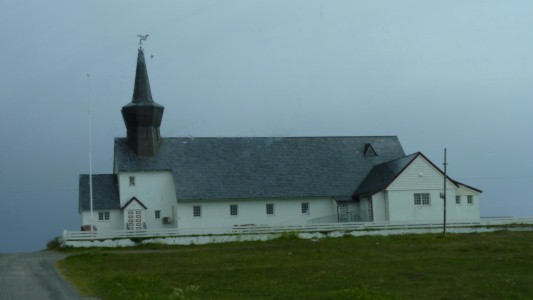
Retracing our steps about 100km south, before we can turn west.
Couldn't help noticing the air conditioner on the wall next to the door. There were also a few on houses.
Something about "selling fridges to eskimoes". Probably used as heater ...
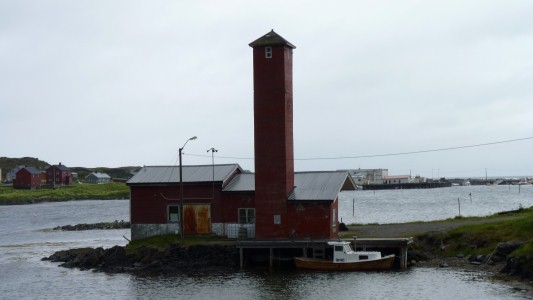
And no one to ask.
Our over active imaginations suggested the fish factory with the tallest tower could be most prepared for boats landing fish.
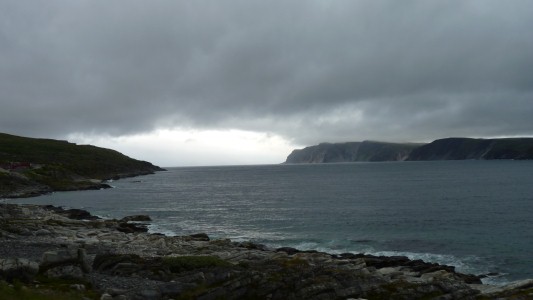
Its to the west of Slettnes.
Another grey day.
We emptied the loo at the dump point on the wharf and filled with water.
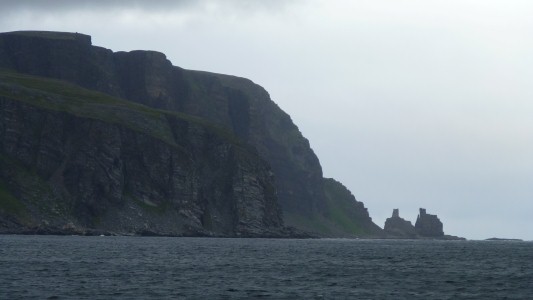
There's a walking track from Kjollefjord but along with the cloud was a biting cold wind.
A "Sea Saami" religious site. Somewhere to say thanks for safe passage in stormy waters.
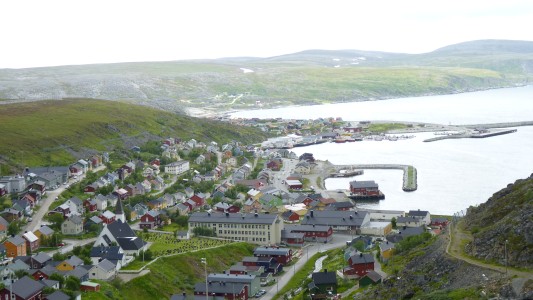
The backup optimus diesel cooker was proving to be a pain in the wind so we bought a small gas cooker and canister.
And a loaf of bread.
We are on a small dirt track to Skjotningberg.
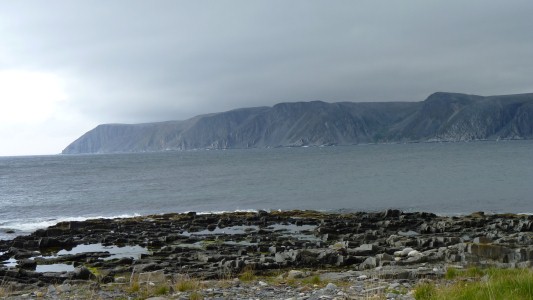
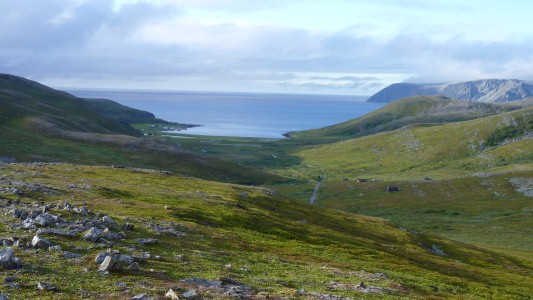
Skjotningberg is the collection of huts on the left hand side.
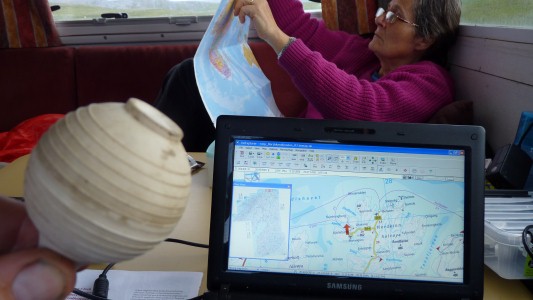
We are getting desperate.
Trying to use the ear syringe to help describe to Ali how the earth is tilted and rotates. How the tropics of cancer and capricorn are where the sun is directly overhead twice a year - so the latitude of the tropics is about the same as the tilt (I think), about 23.5 degrees.. How the arctic and antarctic circles are where the sun is visible 24 hours on at least one day of the year - so the latitude is about the same as 90 - the tilt, about 66.5 degrees..
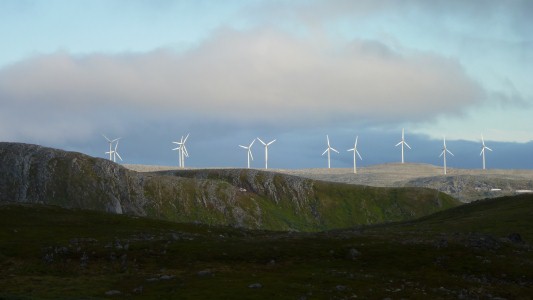
To the south west were the wind turbines supplying Kjollefjord and surrounds with electricity.
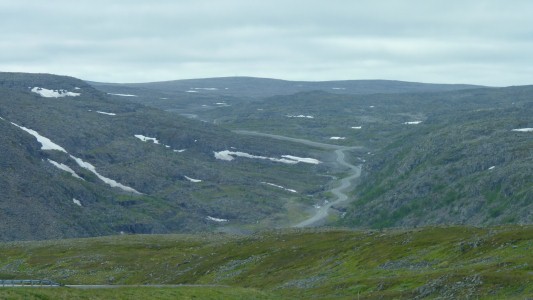
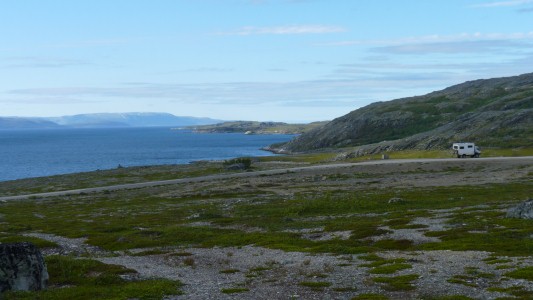
Really just somewhere to stop when we were tired.
Average is about 70 km per day. Relaxing.
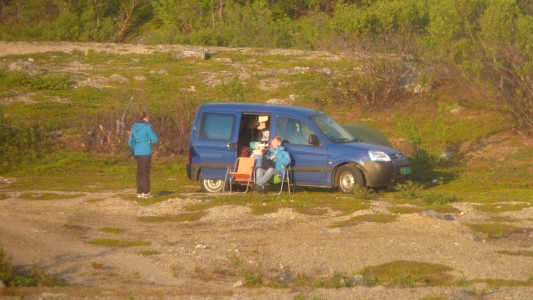
What does one do when the sun is shining at midnight.
Sit and watch it.
And take a photograph of one's partner sitting and watching it.
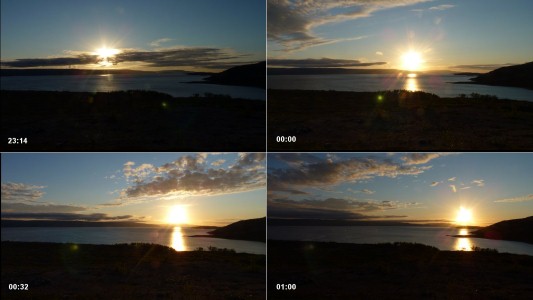
Just long enough to make sure it was rising without having dipped below the horizon.
Oddly, we still have a sense of direction. Just permanent jet lag.
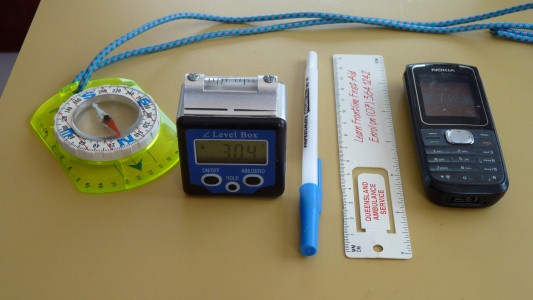
Not having a sextant, or an astrolabe, but armed with a compass, an angle gauge, a ruler, and a mobile phone (for the time) we could take sightings.
The ruler was laid along the top of the angle gauge to measure the elevation of the sun.
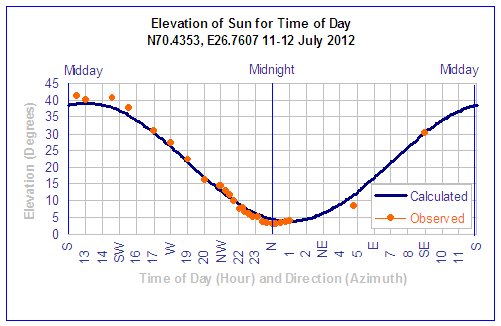
A bit of a challenge trying to visualise it all when out of practice.
The blue line is what I calculated. The orange dots are what I observed.
There's an error somewhere, either in the readings or the calculations, but not bad for a first attempt.
Just guessing that the time zone is probably right for Oslo. We are quite a bit east so the calculation needed an about one hour correction. If I knew the time at Greenwich I could I could work out our longitude but since I know it already I could work out the time!
Also, its not midsummer's day which means there's an extra correction I haven't included.
Galileo and Copernicus would surely have been proud. And now I think I know the Earth is round, not flat (I think - though I'm not about to try the calculations assuming a flat earth).
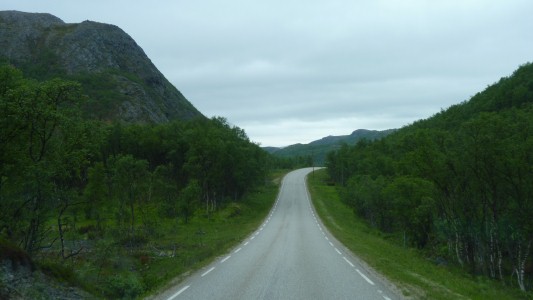
The landscape constantly changes as we are alternately beside the sea or crossing between fjords.
A milder stretch with more substantial birch trees.
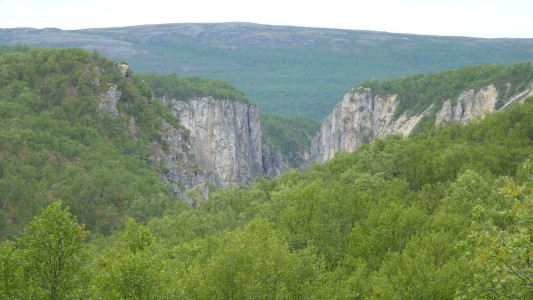
There are two nature reserves. The canyon is the obvious feature but the climate and lime it provides has an effect on the vegetation.
We didn't look closely enough so didn't see the orchids.
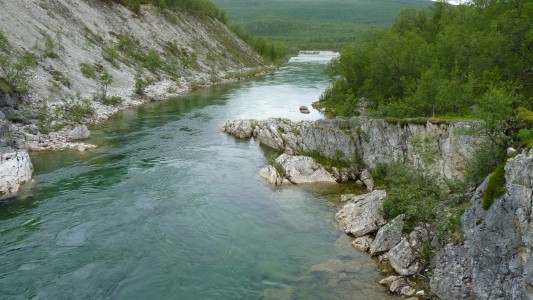
Very clear water with a beautiful deep green tinge.

We followed the rough track along the side of the canyon.
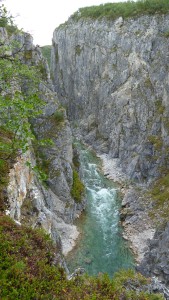
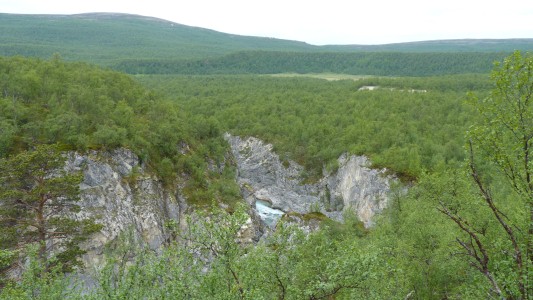
Lots of mosquitoes.
I wonder if we are currently the world's most northerly Australian motorhome?
This is where the river is flowing to.
We've been driving across the plateau for quite a while. Its quite different to where we first entered Norway further east. We can see why this is reindeer herding Saami land.
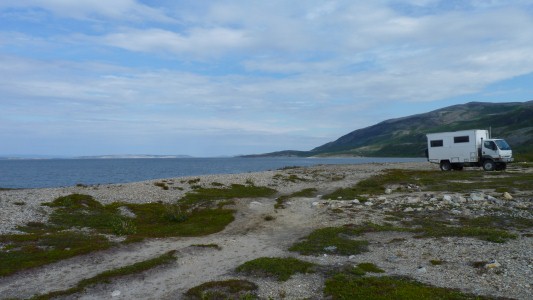
A band of dolomite running east-west.
There's a couple of other motorhomes (with motorhomers) nearby.
Not too close though. The norm seems to be generators rather than solar.
We've driven about 600 km and are now about 180 km by road from Utsjoki, about 80 km for crows.
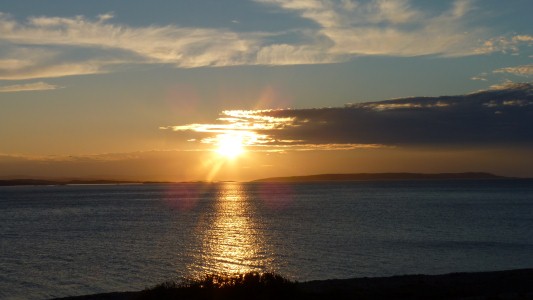
This was taken about 1am. The view from the rear window.
Its also a tad warmer than its been. Low 20's centigrade.
After a week the glowplug for the diesel cooker hasn't turned up at Tim and Angela's (UK) house. UK agent insists its next day delivery. One of those ridiculous and annoying "yes, I know it should have, but it hasn't" conversations. Grrrr.
At the same time I contacted a Norwegian company who took a couple of days to put the part in their system then order it from Webasto. They have an outlet in Narvik. After lots of phone calls I ordered one.
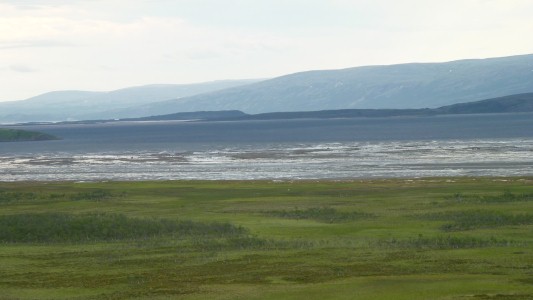
This is Stabburnes Nature Reserve. Ramsay wetland.
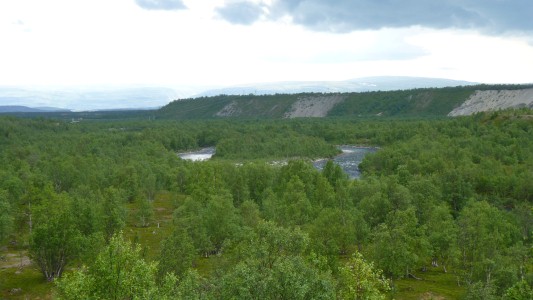
We drove as far as we could then walked along a dirt road. Not feeling good, and walking on dirt roads along valley floors is not our dream occupation, so we turned back after a half hour.
Talked to a couple of salmon fishermen. Most of the park map was taken up with describing zones for fishing.
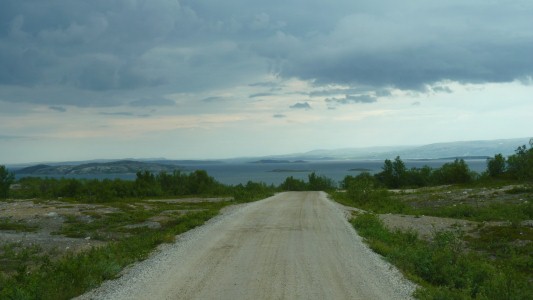
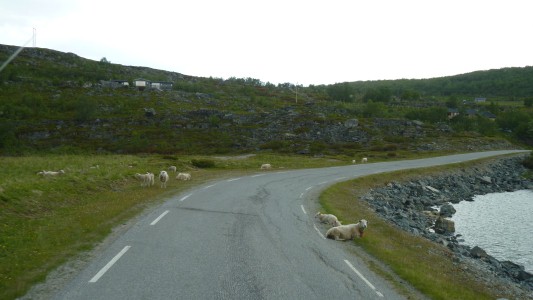
We shouldn't really be surprised.
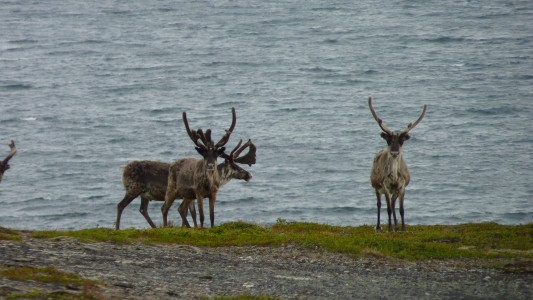
We know that the sheep go "baa", and the cows go "moo", but so far the reindeer haven't tried to speak to us. We're told they sort of go "woof" - like a dog rather than exploding!
These just walked away.
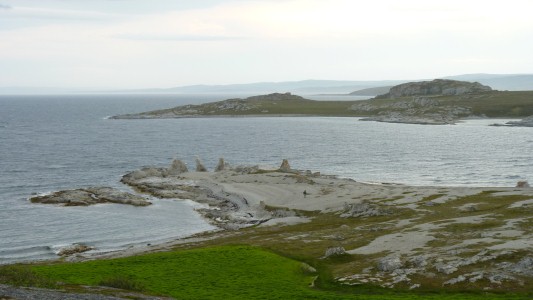
Part of the dolomite band that crosses Porsangen that we'd been near on the eastern side.
At least trolls don't walk away before we get there.
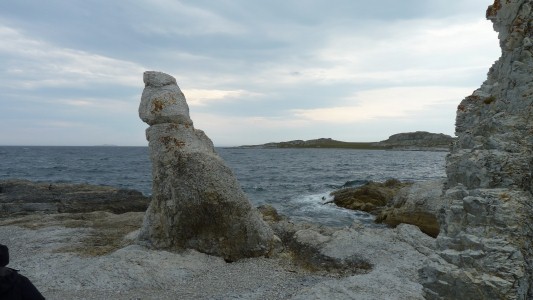
We didn't find the treasure.
We're a bit puzzled as we haven't met trolls in Sweden or Finland yet there are more Saami there.
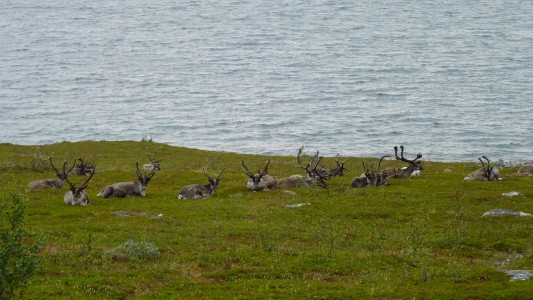
Went for a short stroll towards the sea and happened across a few reindeer.
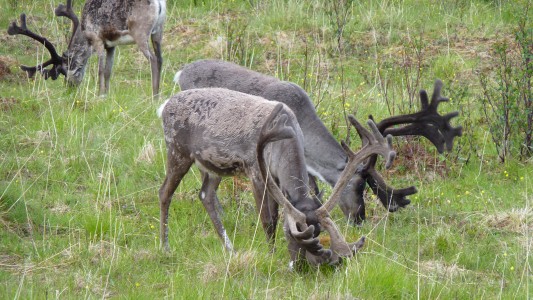
Those antlers look soft and velvety. We think they lose and regrow them every year. Explains why the reindeer we saw further south, earlier in the season, only had stumps.
The antlers are hard to photograph as they move a lot while the reindeer are chewing a little.
And they've nearly finished moulting.
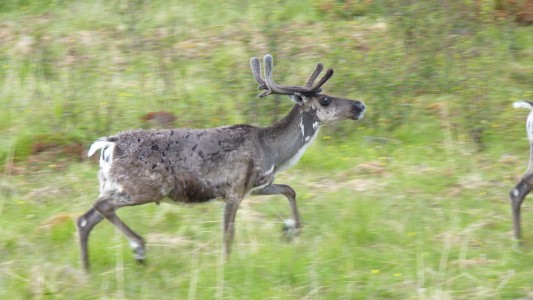
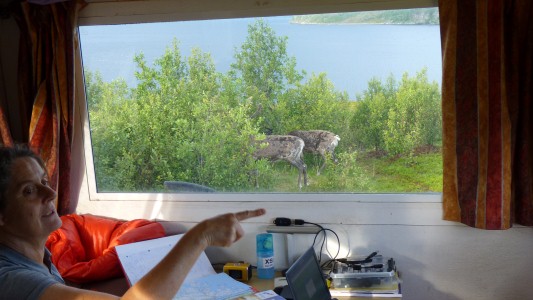
Ali was rugged up because it rained a bit.
"quick - there's one over there!".
They ignored us until I went outside.
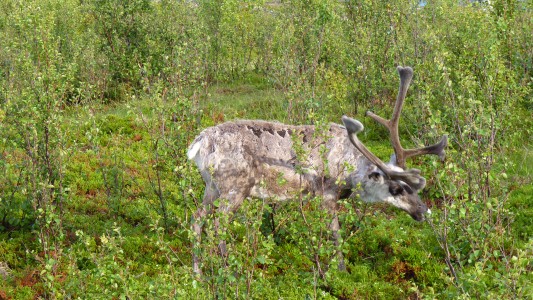
We don't know what the bushes are but the reindeer are eating them. They grab a few mouthfuls of leaves then move onto the next bush. I guess it means there's some left for next time and the bush lives.
They were also eating grass and lichens.
This is their summer feeding ground, they move into the mountains for winter. I'm obviously not a reindeer as I'd do the opposite!
The herd is continuously on the move which reminds us of the herds in Mongolia.
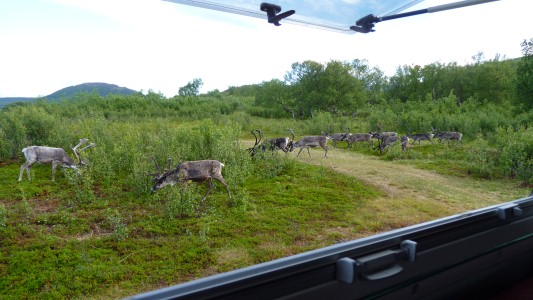
Looked hard but haven't found any of the droppings that we've been assuming are reindeer. Nor many droppings at all.
Some of them have bells round their necks so we know when to look!
We're hoping they won't keep us awake!